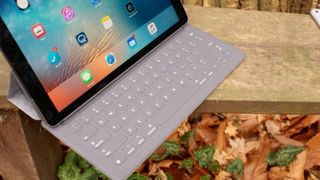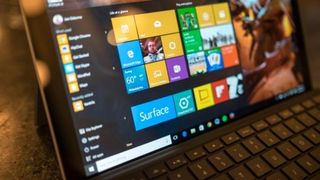iPad Pro versus the Microsoft Surface Pro 4
Battle of the Pros
Ultimately, performance for each slab, for our purposes, comes down to the ability to get work done. Distilled to its purest, this is essentially a battle between iOS and Windows 10, and it's definitely an interesting fight.
Apple's iOS has historically been praised for its simplicity, which is perfect for the quick tasks and media consumption that are typically the domain of phones and smaller tablets. And that simplicity certainly makes itself more apparent than ever - in both good ways and bad - on the iPad Pro.
iOS
In our review, we found the iPad to be absolutely amazing for media consumption, thanks in large part to its gargantuan screen and four excellent dynamic speakers. Basic writing also fared well, with only a small noticeable dip in typing speed on the iPad Pro's keyboard case. Similarly, editing photos was a breeze thanks to a combination of the plethora of quality image editing applications available on the App Store and the slab's powerful innards.
However, in our effort to use the iPad Pro as our sole work machine, the experience fell a bit flat. Simply put, a lot of tasks that are just taken for granted on a desktop OS proved to be frustrating and difficult on iOS. For example, as good as the image editing experience proved to be, getting those images from the camera to the iPad Pro proved to be difficult without a built-in SD card slot.
Multitasking is also a bit of a pain point with the iPad Pro. While most are used to a multi-window environment on a desktop OS, iOS' Split View is limited to two apps side-by-side. At first glance, this isn't a horrible proposition at all. That is, until you realize you can't have two instances of the same app open at the same time. This is fine for taking notes while browsing the web, but it falls flat if you need to have, say, two instances of Safari open side-by-side for one reason or another.

Additionally, if your work happens to entail managing and editing various web-based forms, the lack of a dedicated mouse on iOS can make things cumbersome. For example, working with our web-based CMS proved to be a tedious process of tapping and manipulating various drop down boxes; something that definitely isn't made with a touch interface in mind.
All of that isn't to say that the iPad Pro is a bad choice for all professionals, however. For creatives specifically, the Apple Pencil (despite its silly name) offers an excellent experience for drawing and sketching on the iPad Pro. The tight integration between the stylus and the tablet, along with excellent latency and pressure sensitivity make for a compelling offering.
Are you a pro? Subscribe to our newsletter
Sign up to the TechRadar Pro newsletter to get all the top news, opinion, features and guidance your business needs to succeed!
Windows
So how does the Surface Pro 4 stack up? Despite the actual hardware being more of an iterative improvement on the Surface Pro 3, the latest entry in the Surface line continues to be a great option for those looking to get work done. In terms of productivity, many of the worries that come along with the iPad Pro are negated by virtue of the Surface Pro 4's desktop environment.
Where Microsoft really made some great improvements this year was with the Surface's accessories. The Surface Pen got some notable upgrades to make it a much more useful accessory for getting more done quicker. Most of that has to do with the inclusion of a functional eraser button on top. Not only can you flip the pen to erase, but you can also use varying clicks to open OneNote, take a screenshot, and call upon Cortana for a bit of assistance. Combined with the screen tech, the Surface also now detects 1,024 levels of sensitivity, allowing artists to eke an even greater level of variation into their lines.
Similarly, Microsoft has pushed the Surface Pro 4 even closer to laptop territory with some improvements to the Type Cover. The accessory now features a wider, glass trackpad, and the keys are now slightly further apart and have more travel. All of this adds up to an experience that, we feel, approaches a true laptop experience.

As far as the experience goes, productivity is Windows' bread and butter. Leveraging the typical mouse-based interface of a desktop, the experience is just as it would be using a laptop, including access to any Win32 applications your company may use. Yes, you can use Windows 10 in a purely touch mode if you wish, but most will choose to relegate tablet mode for more casual use.
The one quibble that stands out when comparing Windows to iOS, of course, is the disparity in the app ecosystem. It's worth pointing out that Microsoft's effort to pull developers into its Universal Windows Platform is still in the early stages. The good news is a number of big players have already come forward with plans to support Windows 10, but iOS still offers more variety. This may not even be a concern if you work with a lot of traditional desktop applications or web apps, but it's something to keep in mind.
Verdict
Apple's iPad Pro is certainly a powerful machine. In fact, when looked at purely as a tablet, you'd be hard pressed to find a better alternative in the large-screened space. The problem is, it feels like the iPad Pro is suffering from a bit of an identity crisis. It has great potential to be a productivity powerhouse, but it's held back from heavy work by the restrictions of iOS.
If you're a creative professional, or are simply looking for a large tablet meant to act as a media consumption machine with the added benefit of getting a little work done on the side, the iPad Pro can serve your needs handily. Unless Apple adds mouse support and better file management to iOS, however, those invested heavily in the Apple ecosystem may want to stick with a MacBook for doing heavier work.
Comparatively, the Surface Pro 4 continues to shine due in large part to its OS of choice. The versatility of Windows 10 combined with additional ports and the device's accessories make for a machine that truly does stand out as a machine meant to get work done. That said, all of that can come at a pretty steep price once you dive into the Surface's myriad of customization options.
